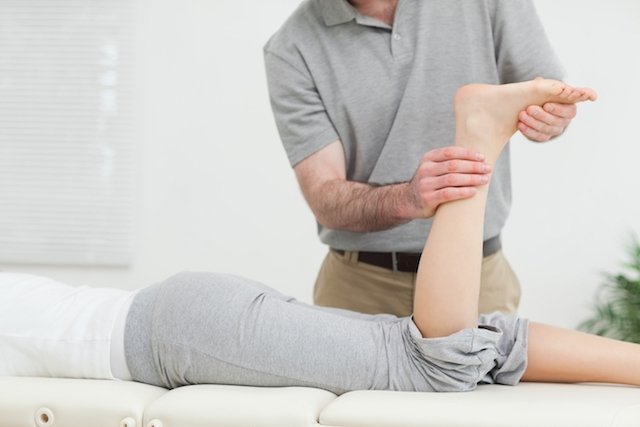Pain in the Achilles tendon can be caused by tendinitis, bursitis, tendinosis or rupture of the Achilles tendon, and is generally related to repetitive movements or excessive use of the tendon.
In addition to heel pain, other symptoms may appear, such as stiff movement, difficulty walking, swelling at the site and the appearance of a lump at the site of the tendon, in some cases.
In the presence of pain in the Achilles tendon, it is important to consult an orthopedist so that the diagnosis can be made and the most appropriate treatment can be initiated, which may involve rest, use of anti-inflammatory medications, physiotherapy and, in some cases, surgery.

Main causes
The main causes of Achilles tendon pain are:
1. Tendinitis
The main cause of pain in the Achilles tendon is tendinitis, or Achilles tendinopathy, which is an inflammation of this tendon, resulting in pain, a burning sensation or stiffness in the heel, which worsens with physical activity, or which may arise especially due to morning.
Achilles tendinitis is more common in professional athletes, caused by repetitive stress on the tendon, but it can also occur in anyone who practices physical activities, such as running or football, for example.
Additionally, Achilles tendinopathy can also occur due to tightness in the calf muscles, especially in people who play sports.
2. Achilles tendon rupture
Achilles tendon rupture is the rupture of the tendon fibers, which separate completely or partially, causing a popping sound when the tendon ruptures, intense pain in the heel or back of the leg, difficulty walking or moving the foot affected.
This rupture of the Achilles tendon occurs due to repetitive movements or excessive stress on the feet or ankles, and is more common in football, running or tennis athletes, for example, who require quick changes in pace or direction.
Furthermore, Achilles tendon rupture can also occur due to Achilles tendinopathy, falling or tripping, or even the use of fluoroquinolone antibiotics.
3. Retrocalcaneal bursitis
Retrocalcaneal bursitis is an inflammation of the bursa, a small sac that serves as a shock absorber and is located between the heel bone and the Achilles tendon, causing intense pain in the Achilles tendon, redness, swelling or a burning sensation.
This type of bursitis is usually caused by excessive use or repetitive movements of the ankle, being more common in athletes, but it can also arise due to gout or rheumatoid arthritis, for example.
4. Tendinose
Achilles tendinosis is a condition in which there is degeneration or progressive wear of the Achilles tendon, unrelated to inflammation, causing progressive and chronic pain behind the ankle and swelling there.
The exact cause of why this happens is still unclear, but it appears to be associated with excessive use of the tendon, decreased local blood flow, and decreased tensile strength common with the aging of the body.
Additionally, Achilles tendinosis also appears to arise due to imbalances, muscle weakness or hyperpronation, which is tilting the foot inward when stepping.
5. Achilles Paratenonite
Achilles paratenonitis is inflammation of the membrane that covers the Achilles tendon, generally caused by the use of inappropriate shoes or repetitive movements, being more common in marathon runners.
This inflammation can cause pain in the Achilles tendon, which worsens when performing physical activities, as well as other symptoms such as swelling or increased sensitivity in the region.
How the diagnosis is made
The diagnosis of pain in the Achilles tendon is made by the orthopedist through the evaluation of symptoms and physical examination, in which movements are performed on the foot in order to assess the intensity of the pain.
Make an appointment with an orthopedist in the nearest region:
Taking care of your health has never been easier!
In addition, imaging tests, such as X-ray or ultrasound, are recommended, which help confirm the diagnosis.
What to do
In the case of pain in the Achilles tendon, you should consult an orthopedist who can recommend the best treatment according to its cause, and generally involves:
- Rest: avoid exertion, but it is not necessary to rest completely, just do not practice physical activity for a few days, for the time recommended by the doctor;
- Ice packs: put crushed ice inside a sock and wrap it around the ankle and leave it for 15 to 20 minutes, several times throughout the day, always paying attention to the skin to avoid causing ice burns;
- Anti-inflammatory medicinessuch as ibuprofen or naproxen, prescribed by the orthopedist: to reduce pain, inflammation or swelling in the Achilles tendon;
- Suitable footwear: wear sneakers or comfortable shoes, avoiding very hard shoes and also high heels, wedge sandals can be worn as long as the heel is no more than 3 cm high, no other type of shoe or sandal with a heel is recommended;
- Physiotherapy: Physiotherapy with stretching exercises, or the use of ultrasound or shock waves, for example, can help reduce pain and inflammation in the tendon.
Additionally, in some cases, your doctor may recommend surgery to repair the Achilles tendon.
Physiotherapy for Achilles tendon pain
In physiotherapy, other electrotherapy resources can be used, such as ultrasound, voltage, laser, infrared and galvanization, for example, with the aim of promoting pain relief and inflammation.
Calf stretching exercises, local massage and then eccentric strengthening exercises, with the leg straight and also with the knee bent, are of great help in curing inflammation of the Achilles tendon.
1. Stretching exercises
To stretch your leg muscles, your physiotherapist may recommend performing the following exercise:
- Climb onto a step and rest your foot on the edge of the step;
- Support your body weight and lower your heel as much as possible;
- Stay in this position for 30 seconds to 1 minute;
Repeat the same exercise with the other leg. Perform 3 stretches with each leg, twice a day, for 1 week.
2. Strengthening exercises
After the period of stretching exercises, it may be advisable to perform strengthening exercises with these same muscles, in which case the same step can be used, as follows:
- Support your feet on the edge of the step;
- Raise your heel as high as you can. Do 3 sets of 10 repetitions.
Other exercises can be recommended by the physiotherapist, according to need, these are just some examples of what can be done at home.

Sign up for our newsletter and stay up to date with exclusive news
that can transform your routine!
Warning: Undefined array key "title" in /home/storelat/public_html/wp-content/plugins/link-whisper-premium/templates/frontend/related-posts.php on line 12
Warning: Undefined array key "title_tag" in /home/storelat/public_html/wp-content/plugins/link-whisper-premium/templates/frontend/related-posts.php on line 13



